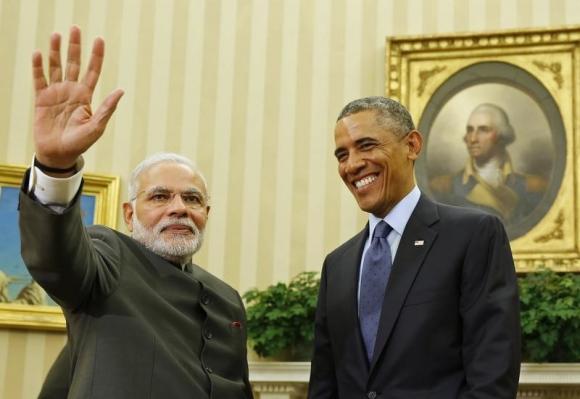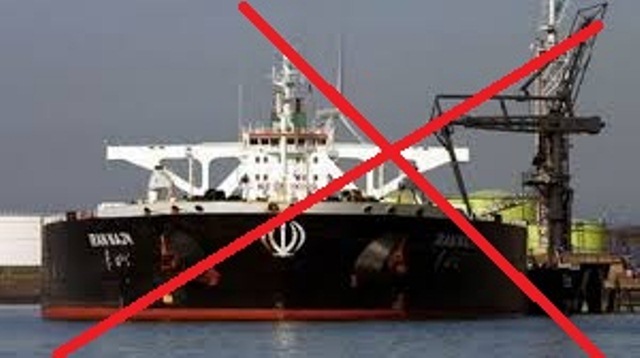-
The European Central Bank has in the meantime taken steps whose consequence keeps oil prices below $50 a barrel.

U.S. President Barack Obama smiles as he hosts a meeting with India’s Prime Minister Narendra Modi in the Oval Office of the White House in Washington September 30, 2014.
China is Iran’s number one oil exports client. India holds second position. The U.S. has demanded that countries taking Iranian oil should not increase purchases from 2013 levels, but India’s imports from Iran rose to 250,200 barrels per day (bpd) in the period April-December 2014, up 41 percent compared with the same period in 2013, according to tanker arrival data made available to Reuters.
China, Tehran’s biggest oil client, has also increased its oil imports from Iran over the last year by about 30 percent. But with reduced purchases from Japan and South Korea, the other main buyers of the oil, Iran’s exports to Asia are holding around 1 million to 1.1 million bpd.
The website Gulf News.Com has quoted Reuters News as reporting that the US has exerted pressure on India to cut oil imports from Iran, and the Asian nation has given in: India has now asked its refiners to slash oil buys from Iran in the next two months to keep the imports in line with the previous fiscal year’s levels, sources with knowledge of the matter said. The decision has been made days ahead of President Barack Obama’s visit to New Delhi.
India, the second-largest buyer of Iranian oil, has raised its crude shipments from there by more than 40 percent over the first nine months of the current fiscal year, when as part of the temporary deal that eased some sanctions on Tehran it was meant to hold them steady.
Now, the sources said, India’s oil ministry has told Essar Oil, Mangalore Refinery and Petrochemicals Ltd and Indian Oil Corp — the Indian refiners that buy from Iran — to cut those imports to keep the annual figure in line with the nuclear deal.
“This is very much about U.S. pressure. India does not want Obama’s visit to be overshadowed by some dispute over sanctions,” said Robin Mills, head of consulting at Dubai-based Manaar Energy.
“India is encouraging its companies to cut back on imports because the U.S. demand has been that countries taking Iranian oil should not increase purchases from 2013 levels,” he said.
Still, India’s imports from Iran rose to 250,200 barrels per day (bpd) in April-December last year, up 41 percent compared with the same period in 2013, according to tanker arrival data made available to Reuters.
China, Tehran’s biggest oil client, has also increased its oil imports from Iran over the last year by about 30 percent. But with reduced purchases from Japan and South Korea, the other main buyers of the oil, Iran’s exports to Asia are holding around 1 million to 1.1 million bpd.
That’s about half of Tehran’s total exports before toughened sanctions aimed at its nuclear activities were put in place in 2012, and a level U.S. officials have said is allowed under the temporary deals that have eased some of the measures and given Iran access to some of its frozen oil revenues.
Iran and six major world powers are due to meet next month to narrow differences over Tehran’s nuclear program after making limited progress earlier in January to clinch a more permanent agreement by a June 30 deadline.
CUTTING OIL IMPORTS FEBRUARY-MARCH
During Obama’s visit, the United States will update India on the progress of the Iran nuclear negotiations, Ben Rhodes, deputy national security advisor in the White House told reporters in a teleconference call.
India’s higher imports from Iran would also be on the agenda, said the two sources in India, who did not want to be named because of the sensitivity of the issue.
“The refiners will have to virtually halt Iranian oil imports in February-March to retain purchases at last year’s levels,” said one of the sources.
Essar, the biggest Indian buyer of Iranian oil, has already said it will not be taking any of the oil over the next two months, said this source, while IOC has said its buys from Iran will be slightly less in the year to March 31, 2015, than in the previous fiscal year.
“MRPL may have to arrange oil from elsewhere as it was planning to lift 100,000 bpd from Iran this year,” the source said.
State-run MRPL has issued a rare spot tender seeking supplies of 1 million barrels of high sulphur oil for lifting during March 1-10, a tender document seen by Reuters shows.
“We are also in talks with other suppliers in the Gulf like Kuwain, ADNOC and Saudi to get additional supplies under our term contract,” an MRPL, source who did not wish to be named said.
MRPL and Essar declined to comment on any government requests to cut purchases from Iran. IOC’s finance head did not respond to phone calls.
“India has cooperated with us in the enforcement of our sanctions regime, which continues to put a significant amount of pressure on the Iranian government and the economy,” Rhodes said in the teleconference call.
Last week, sources in India’s oil ministry said India will also press the United States during Obama’s visit to remove three Indian oil companies from a list naming firms doing business in Iran, and use the opportunity to seek priority access to U.S. LNG exports.
The U.S. president will arrive in New Delhi on Jan. 25 and hold discussions with Prime Minister Narendra Modi, who visited Washington in September.
EUROPEAN CENTRAL BANK ACTION
ThE Washington Post has in the meantime reported that Crude oil in New York dropped as much as 1.4 percent after climbing 2.7 percent earlier in the session. European Central Bank President Mario Draghi announced plans to buy 60 billion euros ($69 billion) a month of public and private debt until September 2016.
The 19-nation shared currency slipped toward an 11-year low against the dollar. A government report is projected to show U.S. crude stockpiles rose last week.
“The ECB announcement has strengthened the dollar, which is going to give the markets a downward bias at least until the inventory data is released,” Thomas Finlon, the Jupiter, Florida-based director of Energy Analytics Group LLC, said by phone. “Dollar strength is the primary factor at the moment.”
West Texas Intermediate crude for March delivery slipped 37 cents, or 0.8 percent, to $47.41 a barrel at 9:18 a.m. on the New York Mercantile Exchange. The volume of all futures traded was 38 percent above the 100-day average for the time of day.
Brent for March settlement fell 7 cents to $48.96 a barrel on the London-based ICE Futures Europe exchange. Volume was up 23 percent from the 100-day average. The European benchmark crude traded at a $1.55 premium to WTI.
The ECB president side-stepped German-led opposition to quantitative easing in a push to revive inflation and the euro- area economy. The risk of deflation and stagnation forced Draghi’s hand six years after the Federal Reserve took a similar step to inject cash into the U.S.
The shift exacerbates a divergence in global monetary policy. While the Fed is now considering when to tighten credit, central banks in Denmark, Turkey, India, Canada and Peru all announced surprise rate cuts in the past week. The Swiss National Bank shocked investors by dropping a cap on the franc.
The Energy Information Administration will probably report that crude supplies increased 2.7 million barrels in the week ended Jan. 16, according to the median of 10 analyst responses in a Bloomberg survey. Data from the industry-funded American Petroleum Institute on Wednesday, January 21, 2015, showed an increase of 5.7 million barrels for the period, according to reports on Twitter.
Producers outside the Organization of Petroleum Exporting Countries should be first to reduce their output amid a surplus that’s pushed crude below $50 a barrel, Secretary-General Abdalla El-Badri said in an interview with Bloomberg Television.
A price recovery is likely in the second half, International Energy Agency Chief Economist Fatih Birol said at a conference in Davos on Wednesday.
“In the second half of this year we will see an upward pressure on prices starting, and therefore I believe this $45 oil price now is a temporary phenomenon,” Birol said.




